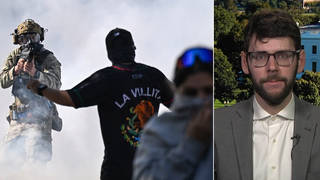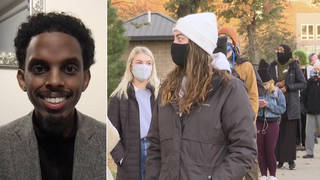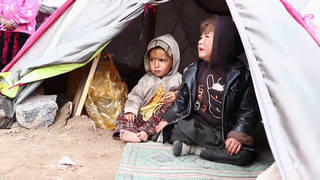
The World Food Program has warned Afghanistan faces a “tsunami of hunger” as the economy continues to collapse, due in part to U.S. sanctions and the freezing of Afghan assets following the Taliban takeover of Kabul. Meanwhile, President Biden once again defended his decision to withdraw U.S. troops from Afghanistan on Wednesday without acknowledging the humanitarian crisis that followed his exit. We speak with journalist Jane Ferguson, who recently traveled to Afghanistan to report on the collapse of basic government services and the various factors that led to the collapse of the economy, which she says was “completely reliant on international aid.” She also speaks about the “massive pressure” the White House is under to respond to the humanitarian crisis, as well as the Taliban’s handling of the growing women’s rights movement. “What these women really need is more eyes on their movement, more of them on air, more of their voices being put on television and in the newspapers,” she says. Her most recent New Yorker piece is titled “Afghanistan Has Become the World’s Largest Humanitarian Crisis.”
Transcript
AMY GOODMAN: This is Democracy Now!, democracynow.org, The War and Peace Report. I’m Amy Goodman.
The World Food Program is warning Afghanistan is facing a, quote, “tsunami of hunger.” The group estimates 23 million Afghans face acute food shortages, including nearly 9 million who are close to starvation. Afghanistan’s economy collapsed after the U.S. and international financial organizations froze Afghan assets after the fall of Kabul.
Earlier this week, Senator Bernie Sanders urged President Biden to take immediate action. Sanders wrote, quote, “Afghanistan is facing a humanitarian catastrophe. I urge the Biden administration to immediately release billions in frozen Afghan government funds to help avert this crisis, and prevent the death of millions of people.”
We’re joined now by Jane Ferguson. She’s a special correspondent for PBS NewsHour, contributor to The New Yorker. She’s reported extensively from Afghanistan over the years and was in Kabul as it fell to the Taliban in August last year. She returned to Taliban-controlled Afghanistan in November to report on the humanitarian crisis. Her latest piece for The New Yorker, “Afghanistan Has Become the World’s Largest Humanitarian Crisis.”
Jane, welcome back to Democracy Now! In your piece, you write, “Exhausted mothers stood next to the beds and stared wide-eyed at their babies. One leaned over, sang lullabies, and gently kissed her child’s cheek. … About a third of the children who arrive at the unit do not survive. … The new government is struggling to feed the country’s thirty-nine million people, and the chance that an Afghan baby will go hungry and die is the highest in twenty years.” Can you describe the suffering you saw in this neonatal unit, and not only in this one hospital, but what you found? I mean, the worst it’s been in 20 years, since the U.S. invaded Afghanistan, you’re saying.
JANE FERGUSON: Yes, Amy. What we’re really seeing is the collapse of not only any kind of economic means for those mothers and their husbands to be able to make enough money to feed the children or to be able to make enough money to feed themselves and lactate babies, but we’ve also seen a compounding crisis because the medical institutions and the medical facilities across the country have also been collapsing. You know, once the flow of money, once the economic institutions just froze across the country, then you couldn’t see anybody who worked at these facilities getting paid or any of the flow of money coming in. So you have families across the country with no income. And then, when they take their children to the hospital because they’re malnourished, because there are such high cases of malnourished babies, many of them have to go to whatever units are open.
And in that story, I was describing a unit in Kabul, which was one of the few that was still operating. And those beds with babies were sometimes three, four babies in a bed. The hospital staff, many of whom hadn’t been paid in months, were basically trying to keep them alive but said that infections were just running riot through the units because they just don’t have the medicines, they’re completely overwhelmed with malnourished babies and massively understaffed. Many of those mothers that I described will have had to come from rural areas where local clinics have — many of them have completely collapsed. A recent statistic by Save the Children in Afghanistan said that as little as 17% of medical facilities across the country are now fully operational.
AMY GOODMAN: Can you talk about exactly what the U.S. has frozen in terms of assets, and how you saw that directly translating to hunger and poverty on the ground in Afghanistan?
JANE FERGUSON: Well, when we look at the economic collapse in Afghanistan, we do broadly need to look at two major factors, although it is much more complex than that. On the one hand, we had the Afghan government assets, of about nine-and-a-half, close to $10 billion, that were being held overseas, many of them in the United States. Those were frozen instantly when the Taliban swept into Kabul and the government collapsed on August 15th of 2021. Now, they were frozen because the international community and the United States, the White House, didn’t want that money falling directly into the hands of the Taliban and the Haqqani leadership that had marched into Kabul that day.
And so, effectively, by freezing that money, we’ve also seen — and the sanctions that have come along with it — we’ve also seen the economic system in Afghanistan collapse. It became either illegal or extremely risky legally to send money in and out of Afghanistan. As a result, there were basically financial constraints on every bank in Afghanistan. At one point — and I do believe this is still the case now, but it might be even worse because it changes day to day — families and bank account holders were told they could get $200 a month of their own money out of the banks. So the banking system, as a result, also collapsed. And much of that money would have been used by a government of Afghanistan to pay their workers. As with many countries around the world, the government is the main employer. Whether or not you’re a road sweeper or you’re a schoolteacher or you’re an economist in a bank, typically you will be getting a salary from the government. Once that stops, you just have an absolutely cataclysmic cash flow stop in the economy, as well as the banking crisis.
Now, on top of that, you saw an NGO community, the charities and the international charities that have been working in Afghanistan for 20 years or more, leave the country, and for it to become incredibly difficult for them to send money into the country because of sanctions and legal problems. Now, Afghanistan’s economy was completely reliant on international aid. And it’s these issues that have basically caused incomes in Afghanistan to collapse. There’s plenty of food in the country, but nobody has any money.
AMY GOODMAN: I remember moderating a panel over a decade ago of women in aid organizations in Afghanistan, from foreign aid organizations. This is far before it was clear the Taliban would take over, you know, a decade later. And they said it is very clear we’re here because the U.S. soldiers are here; when the war ends, they will stop funding these aid organizations. Talk about what a donor economy means and what Afghanistan has been left to cope with now.
JANE FERGUSON: Basically, you know, fundamentally, structurally, one of the biggest failures — in fact, I would argue it may be the biggest failure — in Afghanistan over the last 20 years of the U.S.-led efforts there hasn’t just been the collapse of the Afghan security forces. There was so much discussion following the fall of Kabul as to how it’s possible that we could have invested so much money and time and effort in the Afghan security forces and then they collapsed. But underlying all of this has been a failure to build a functioning, even remotely independent, self-sustaining economy in Afghanistan. What we had was ingrained aid dependency and corruption. And those two things really undermined, essentially, any real development of industry, entrepreneurialism. There were very many young educated Afghans who wanted to try to build businesses, that would have created some revenue streams back to the government, but corruption made that extremely difficult, and the instability of the war. So, anybody who was running a business in Afghanistan, even if that was a legitimate, authentic business that was not funded by the international community, very often — and I talked about this in the article — very often those profits were siphoned out of the country and put elsewhere for safekeeping, partly because of the instability in the country and the corruption. So, the government was never really able to bring in tax revenue.
And I spoke also with the acting finance minister, who was there right up until the collapse of the government, who also talked a lot about how the aid economy can sometimes ingrain a level of dysfunction within the country. For instance, you know, sometimes we think that aid is much more coordinated than it is. But over the last 20 years in Afghanistan, we’ve seen examples of how aid can be patchy. It can be politicized. You know, one country might give aid only for education in this one area. And you don’t necessarily have an empowered government, central government, that can then plan and organize its economy and running its country. And so, in many ways, the international community was financially running Afghanistan. And when you add that in with the levels of corruption in politics and finance in Kabul, and a war and violence that was undermining any attempts to build a really sustaining economy, then you just didn’t have revenues to a government.
AMY GOODMAN: You say that more Afghans may die from U.S. sanctions than died at the hands of the Taliban. If you can elaborate on that? And also, how much does the Biden administration respond, understand of what’s going on right now? You have President Biden continually asked, you know: Should he have pulled out of Afghanistan? Is that really the right question to ask him, rather than what should be happening right now?
JANE FERGUSON: Well, what happens a lot, Amy — and we heard this from the Biden administration a couple of days ago when asked about competency and the government when it comes to Afghanistan — is it doesn’t matter whether he’s asked, “Was there a strategy?” He answers the question, “Should we have stayed?” And that has been the policy from the very beginning, from the collapse of the government in Afghanistan, from the chaotic, deadly last-minute withdrawal and exodus from the country. The White House won’t answer the question, “What is the strategy? What was the strategy? What will it be going forward?” — more details on what they plan to do to prevent the current reality getting any worse. Instead, what we hear repeatedly, and we have heard for months now, is it was right to leave. And that was very much so the case in August of 2021 as scenes were playing out at Kabul airport, and it is still today. The White House’s policy is to answer the question they wish they had been asked, which is, “Should we have stayed in Afghanistan?” And so, the answer is always, “We left because it was costing too many American lives, and we left because it was costing too much in American dollars.”
The problem is that the White House is under massive pressure to respond to the situation as it is, as a reality today, which is that Afghanistan could face a devastating famine, and that the crisis is unfolding at such a pace that the reaction by the White House, which has often been to respond in time once pressure builds just enough, and that, that sort of slow, piecemeal, almost ad hoc policymaking to Afghanistan, is unlikely to keep apace with the level of the crisis, because the freefall is so fast. So, for instance, in December, we saw some carveouts being announced by the Treasury Department to the sanctions to make it slightly easier to send money to Afghanistan. So, the money — you can send money to Afghanistan, and it can technically go through the hands of the Taliban or the Haqqani Network, so long as it only ends up there on the ground and used for humanitarian efforts — very difficult to ensure. But again, that’s in response to the pressure being put on, not just domestically in the United States, but the White House also has to make sure that it’s not on the defensive against rhetoric from the Taliban. The Taliban will find it very easy to turn around and say this is a Joe Biden famine, or America created this famine, created and owns this humanitarian crisis. So, they’re, very much so, going to use it for their own PR purposes, as well. So, going forward, the White House continues to be under pressure to actually respond with some sort of strategy rather than continue to simply go over the same talking points, which were — which are it was right to leave, the time was right, it was a tough choice.
AMY GOODMAN: So, let me talk more — ask you more about the Taliban’s treatment of women in Afghanistan. On Wednesday, the Taliban raided the home of Tamana Zaryabi Paryani, a women rights activist in Kabul, just days after she took part in an anti-Taliban protest. Tamana posted this video online when the Taliban arrived at her apartment.
TAMANA ZARYABI PARYANI: [untranslated]
AMY GOODMAN: This is not translated, but, of course, you can hear the fear in the voice of Tamana Zaryabi Paryani. She was arrested soon after, along with her three sisters. If we can end with this issue and what you feel needs to happen now, Jane?
JANE FERGUSON: Amy, I can relay what these women have been telling me. When I was on the ground in November, I attended one of their street protests. And they ask the media to come. They want the international press, in particular, to come and cover these issues. And they say, very clearly, “We feel safer when you are here.” There’s a reason she put that video online. She knows that the Taliban would shoot those women dead in the street if there weren’t video cameras there and the international press ready to cover it.
The Taliban are trying to do a dance between not looking like they’ve gone soft, because they’re at war with ISIS — they don’t want to lose fighters, they don’t want to lose face, they don’t want to lose commanders, territory, resources, so they have to look like they haven’t gone soft as they’ve taken over the country, or become Westernized in some way. Women’s issues are a very effective tool for them to display that. But at the same time, they’re trying to get recognized internationally.
So, they — whenever I was in the street trying to cover a protest, they forced me and my cameraman back into the car at gunpoint and told us it was for our own security because there could be an ISIS attack, and then surrounded a group of women who were calling for women’s rights, and threatened to take our filming equipment if we filmed them.
So, going forward, what these women really need is more eyes on their movement, more of them on air, more of their voices being put on television and in the newspapers. They are afraid that the minute the world’s view, the world’s cameras are turned off from them, the Taliban will continue to do exactly what we saw in that video, which is come to their houses and disappear them.
AMY GOODMAN: Jane Ferguson, I want to thank you for being with us, special correspondent for PBS NewsHour and contributor to The New Yorker. We’ll link to your latest piece, “Afghanistan Has Become the World’s Largest Humanitarian Crisis.”
Next up, we look at how the Biden administration was in court this week defending its use of Title 42, the Trump-era policy which allows the U.S. to expel recently arrived migrants without due process. Back in 30 seconds.












Media Options